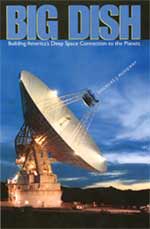
The focal points in this book are the three largest communication antennas built by NASA, the backbone of the deep space network. Built roughly 120 degrees apart around the globe; Goldstone in California, Canberra in Australia, and Madrid in Spain, they spanned 64 metres in diameter originally though were later upgraded to 70 metres. Perhaps barely acknowledged by most space enthusiasts, they perform the critical service of linking us to our robot progeny in our reach off of Earth. Probes get sent commands to fire thrusters and in return send bits and bytes of video images of planets and moons. Robots get instructions to travel foreign terrains and provide visual treats of foreign lands. And perhaps most exciting, people on the moon interacted in (near) real time with Earth based operators. And lunar travel is the point in time when this book’s story begins.
Mudgway lays the groundwork to his story by outlining some of the significant political and space related issues. In the heydays of the 1960’s, a ready fiscal budget for space helped ensure the winning of the race and the build out of infrastructure like the antennae. Though the technology was still in its infancy a quick ramp up had to occur to meet the expectations of the space progam. On top of this groundwork he then builds a description of the existing state of technology and the requirements for the location and operation of the new antennae. What then follows in the book is an easy reading, chronologically arranged narrative of how the chosen people made it happen.
The narrative itself reads more like a fire side chat than like a specific technical treatise. The historical background and political circumstances embellish the reasoning for site selection. People’s names crop up, predominantly Bill Merrick the design and construction manager. Some of their more colourful actions and sayings enliven the text and remind the reader that people, not structures, were the central concern. Company names and their involvement get a slice of attention as well. So, as much as this book’s subject concerns the history of the antenna stations of the deep space network, the inclusion of people and extraneous events keeps the reading light and easy.
Nevertheless, the antenna stations are the main focus and there is a lot to learn within the book. Site selection had to meet limits on radio interference, ground stability and proximity of a workforce, even if Bogong moths were the initial main residents. Component fabrication and site build out gets a thorough description, from the laying of the continuous concrete ring 100 feet in diameter, 11 feet wide and 3 feet deep to using the quadripod support to install the feed system. In a pleasant manner, Mudgway effectively includes a sense of urgency by continually noting the need for the antenna to either support the manned space program or to be ready for a space probe doing a “once only” fly by of a distant planet.
Construction of the antenna encompasses a major portion of the book, though Mudgway also includes goodly portions on the operations and maintenance. We read how, just like a private residence, the antennae’s demands continually expanded to quickly exceed 100% availability. Then upgrades and procedure modifications allowed for better (faster and greater) abilities whose benefits were again quickly consumed by voracious researchers. Routine issues must have arisen, though none are included. Two major problems arose and are noted. One involves azimuthal motion. Oil allows a pad to travel across a steel runner. But if the runner gets uneven, contact occurs, and the antenna couldn’t turn until after signficiant repair work. In elevation, gears and bearings allowed the 4,000 ton dish to rotate in elevation, that is, until the bearings cracked. Again, things got very stressful and Mudgway does a wonderful job of describing the event, the people and the fix.
In a conversational, light tone, using generalist language, Mudgway gives an easy reading history of the antenna stations and the people involved. A reader can pick up some on the design and construction of the antenna and the people involved, however, don’t expect to learn much on the intricacies of microwave design or operation. Also, though chronological, the flow is uneven, at times like an old river that wanders and meanders without a clear focus, even though a destination does get reached.
The deep space network is the phone network that allows people to communicate with their mechanical offspring throughout our solar system. Douglas Mudgway in his book Big Dish, Building America’s Deep Space Connection to the Planets, gives a very smooth historical narrative of the people and events around the design, construction and upgrade of the three largest of the antennae.
Click here to read more reviews or order a copy online from Amazon.com.
Review by Mark Mortimer
